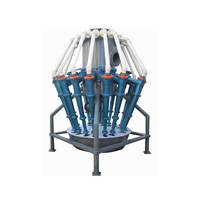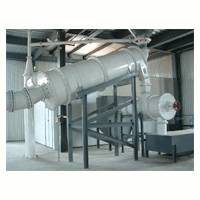Hydrocyclone
Product description
The hydrocyclone is a common separation and grading equipment, commonly used centrifugal sedimentation principle. When the slurry is separated, it is forced to make a rotary motion after entering the cyclone around the cyclone. Due to its by the centrifugal force and centripetal buoyancy and fluid drag force, different size of solid coarse particles in the slurry to overcome the hydraulic resistance to the wall movement, and under the joint action of its own gravity, along the wall spiral downward movement, the fine and small particles and most of the water because of the centrifugal force is small, not close to the wall with slurry for rotary motion. In the subsequent feeding, the particle size is increasing from the center to the wall, forming a layered arrangement. As the slurry from the cyclone cylinder parts flow to the vertebral body, flow cross section is more and more small, in outer slurry shrinkage of oppression, contains a lot of tiny particles of inner slurry has to change direction, turned upward movement, formed in hydrocyclone, the overflow pipe discharge,become the overflow; However, the large particles continue to spiral downward in the wall of the wall, forming the outer swirl, which is eventually discharged by the bottom flow and becomes the settling sand. Thus, the purpose of separation classification is achieved.
About installation
Operation Mode:
1. Before starting the test, make sure that all the connecting points of the cyclone unit have been fastened, removing the various residues in the pipe and cabin, so as not to leak and jam after driving. Be sure to open the valve fully in operation.
2. The valve may be fully opened (such as running swirler) or completely closed (such as a back-up cyclone), but it is not allowed to be in a semi-open state (i.e., the valve shall not be allowed to control the flow).
3. If possible, please test the car with water first. The feed of the cyclone can be supplied by pump or high tank. If the pump and the cyclone throughput match, the pressure gauge shows a constant reading. To ensure that the pressure gauge readings are not fluctuating, if there is any obvious fluctuation, check the reason. The equipment is required to work under 0.3MPa pressure.
4. When the equipment is running smoothly under normal pressure, check the leakage quantity of joints and take remedial measures when necessary.
5. Check the blockage caused by the flow into the cyclone. The blockage of the flow inlet of the cyclone can reduce the flow of overflow and sink sand, and the clogging of the cyclone can reduce the flow of the settling sand and even the flow. If the blockage occurs, close the cyclone to the material valve and remove the blockage. To prevent blockage, in feeding hydrocyclone group pools can be added to prevent coarse material and sundry facilities (e.g., trash screen), at the sametime when parking should be timely to feed pool emptying, lest again when driving cause blockage accident due to precipitation, and concentration is too high.
6. When the equipment is proved to be in good operation with water test, it can be used for feeding the slurry.
Performance data
Main Parameters:
Tube diameter (mm): 100 or 150 or 250 or 300 or 500 or 600
Taper: 8 or 10 or 15 or 17 or 20
Overflow tube diameter (mm): 20-40 or 30-45 or 60-100 or 65-115 or 130-200 or 170-220
The sink diameter (mm): 8-18 or 8-22 or 16-45 or 20-50 or 35-100 or 75-120
Maximum feeding size (mm): 1 or 1.5 or 3 or 5 or 6 or 10 or 13
Grading granularity (micron): 20-100 or 30-100 or 40-100 or 50-150 or 74-200
Processing capacity (m3 / h): 5-12 or 20-40 or 40-60 or 60-100 or 140-220 or 200-300






